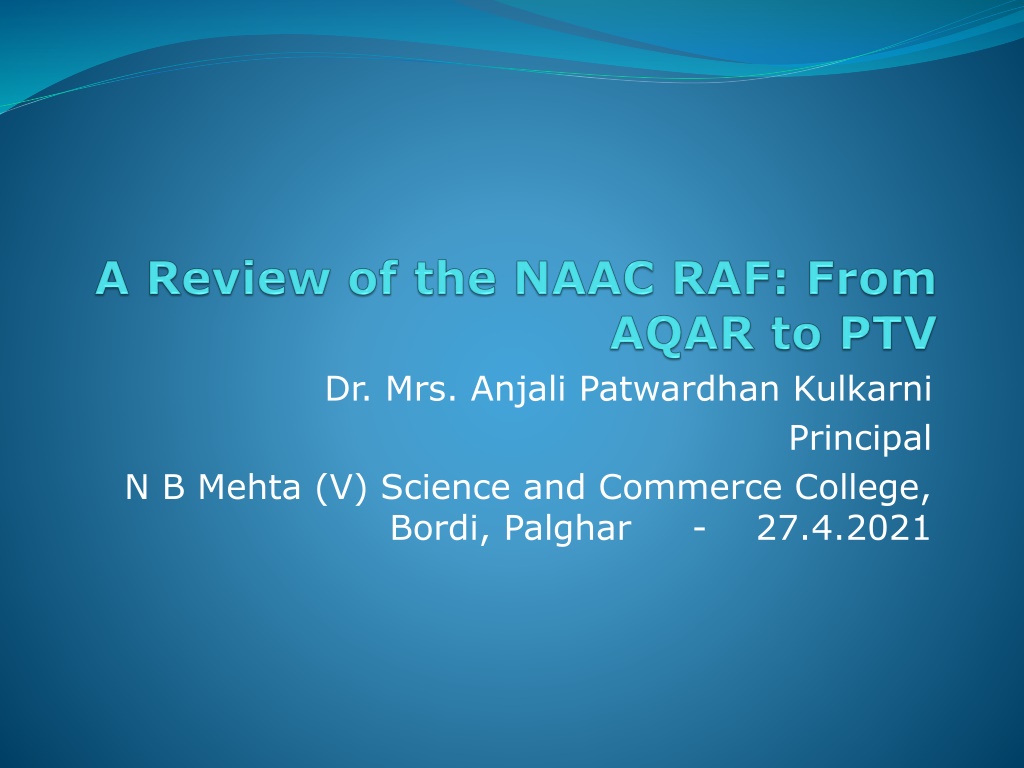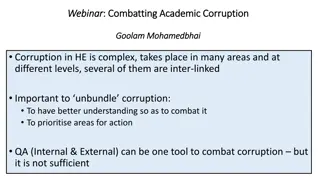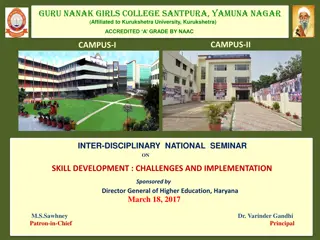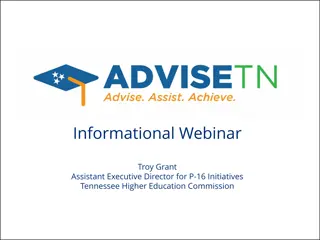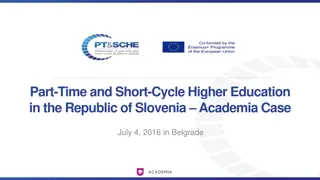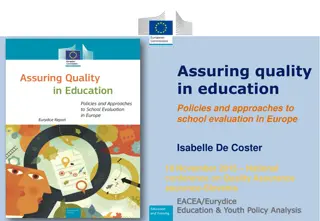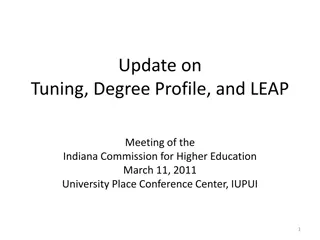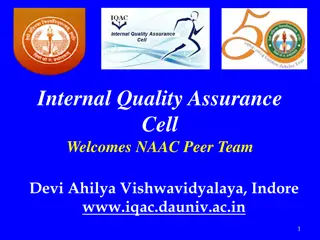Overview of NAAC Initiatives in Higher Education Quality Evaluation
Dr. Mrs. Anjali Patwardhan Kulkarni, Principal of N.B. Mehta (V) Science and Commerce College, shares insights on the relevance of AISHE, importance of IQAC, FAQs on IIQA and AQAR, Executive Summary aspects, and Revised Accreditation Framework criteria. The visionary mission of NAAC aims to promote quality in Indian higher education through self and external evaluations. NAAC's value framework emphasizes national development, global competencies, values, technology, and excellence. Continuous revisions in IQAC and AQAR guidelines ensure quality enhancement. The Revised A&A Framework introduced in July 2017 drives the process forward.
Download Presentation

Please find below an Image/Link to download the presentation.
The content on the website is provided AS IS for your information and personal use only. It may not be sold, licensed, or shared on other websites without obtaining consent from the author. Download presentation by click this link. If you encounter any issues during the download, it is possible that the publisher has removed the file from their server.
E N D
Presentation Transcript
Dr. Mrs. Anjali Patwardhan Kulkarni Principal N B Mehta (V) Science and Commerce College, Bordi, Palghar - 27.4.2021
Topics for Today 27.04.2021 1) Relevance of AISHE-All India Survey on Higher Education 2) Importance of IQAC- Internal Quality Assurance Cell 3) FAQs regarding-- i) IIQA: Institutional Information for Quality Assessment ii) AQAR: Annual Quality Assurance Report (short annual self study report) 4) Important Aspects of the Executive Summary 5) Criterion 1,2 and 3 in the REVISED ACCREDITATION FRAMEWORK (RAF)
VISION To make quality the defining element of higher education in India through a combination of self and external quality evaluation, promotion and sustenance initiatives
NAAC: MISSION To arrange for periodic assessment and accreditation of institutions of higher education or units thereof, or specific academic programmes or projects; To stimulate the academic environment for promotion of quality of teaching-learning and research in higher education institutions; To encourage self-evaluation, accountability, autonomy and innovations in higher education; To undertake quality-related research studies, consultancy and training programmes, and To collaborate with other stakeholders of higher education for quality evaluation, promotion and sustenance.
NAAC : Value Framework To promote the following core values among the HEIs of the country: Contributing to National Development Fostering Global Competencies among Students Inculcating a Value System among Students Promoting the Use of Technology Quest for Excellence
Continuous Revision of Guidelines for IQAC and AQAR 1) Revised on 26th September, 2019 2) Revised on 20th February, 2020 Version 7 3) Draft placed on NAAC website for suggestions until 28 May 2020
Revised Assessment and Accreditation (A&A) Framework Launched in July 2017, making the process ICT enabled, objective, transparent, scalable and robust The Shift is: 1. from qualitative peer judgment to data based quantitative indicator evaluation 2. towards extensive use of ICT confirming scalability and robustness 3. simplification of the process by drastic reduction in number of questions, size of the report, visit days 4. boosting benchmarking as quality improvement tool 5. introducing Pre-qualifier for peer team visit, as 25% of system generated score
Revised Assessment and Accreditation (A&A) Framework 6. introducing System Generated Scores (SGS) with combination of online evaluation (about 70%) and peer judgment (about 30%) 7. introducing the element of third party validation of data 8. providing appropriate differences in the metrics, weightages and benchmarks to universities, autonomous colleges and affiliated/constituent colleges 9. revising several metrics to bring in enhanced participation of students and alumni in the assessment process
Appendices Appended to the Manual 1. Appendix 1: Glossary & Notes 2. Appendix 2: Abbreviations 3. Appendix 3: Guidelines for Institutions to opt out Non Applicable Metrics 4. Appendix 4 : Optional Metrics for Affiliated/Constituent Colleges
Pre-requisites for submission of IIQA IIQA :Institutional Information for Quality Assessment Have a functional IQAC. The minutes of IQAC meeting and compliance to the decisions should be uploaded on the institutional website. Mandatory submission of AQARs on a regular basis for institutions undergoing the second and subsequent cycles of Assessment and Accreditation by NAAC. Upload the AQAR on institutional website for access to all stakeholders.
Pre-qualifier The Quantitative Metrics (QnM) of SSR will be sent for Data Validation and Verification (DVV) Process. After DVV process, a DVV deviation report will be generated. On the basis of the deviation report, the A&A process will proceed further as per the following conditions: a) HEI whose Metrics are found to be deviated will be liable for the penalty or legal action. Their first installment of accreditation fees will also be forfeited, and the name of such HEI will be sent to statutory authorities for further actions.
Pre-qualifier b) HEI that clears the DVV process will proceed for Peer Team Visit with a condition of a Pre-qualifier, that the HEI should score at least 25% in Quantitative Metrics (QnM) as per the final score after the DVV Process. If the HEI does not clear the Pre-qualifier stage then they will have to apply afresh by submitting the IIQA and its fees. Such HEIs are eligible to apply again only after six months from the day of declaration of Pre-qualification status. After the DVV process, NAAC will intimate the HEI, regarding the status of the pre-qualification. Only pre- qualified HEIs will enter the next round of assessment to be done by the Peer Team during their on-site visit. The focus of Peer Team visit will be on the Qualitative Metrics (QlM).
Guidelines for forming IQAC Establish an Internal Quality Assurance Cell (IQAC) as a quality sustenance measure to develop a system for conscious, consistent and catalytic improvement in the overall performance of institutions IQAC Vision To ensure quality culture as the prime concern for the Higher Education Institutions through institutionalizing and internalizing all the initiatives taken with internal and external support.
Guidelines for forming IQAC Objectives The primary aim of IQAC is To develop asystem for conscious, consistent and catalytic action to improve the academic and administrative performance of the institution. To promote measures for institutional functioning towards quality enhancement through internalization of quality culture and institutionalization of best practices.
IQAC : Strategies IQAC shall evolve mechanisms and procedures for a) Ensuring timely, efficient and progressive performance of academic, administrative and financial tasks b) Relevant and quality academic/ research programmes c) Equitable access to and affordability of academic programmes for various sections of society
IQAC : Strategies d) Optimization and integration of modern methods of teaching and learning e) The credibility of assessment and evaluation process f) Ensuring the adequacy, maintenance and proper allocation of support structure and services g) Sharing of research findings and networking with other institutions in India and abroad
IQAC : Functions Some of the functions expected of the IQAC are: a) Development and application of quality benchmarks b) Parameters for various academic and administrative activities of the institution; c) Facilitating the creation of a learner-centric environment conducive to quality education and faculty maturation to adopt the required knowledge and technology for participatory teaching and learning process
IQAC : Functions d) Collection and analysis of feedback from all stakeholders on quality-related institutional processes d) Dissemination of information on various quality parameters to all stakeholders e) Organization of inter and intra institutional workshops, seminars on quality related themes and promotion of quality circles
IQAC : Functions f) Documentation of the various programmes/activities leading to quality improvement g) Acting as a nodal agency of the Institution for coordinating quality-related activities, including adoption and dissemination of best practices h) Development and maintenance of institutional database through MIS for the purpose of maintaining /enhancing the institutional quality
IQAC : Functions i) Periodical conduct of Academic and Administrative Audit and its follow-up j) Preparation and submission of the Annual Quality Assurance Report (AQAR) as per guidelines and parameters of NAAC. New AQAR would facilitate Educational Institutions for creating a good database at Institutional level for enhancing the quality culture.
IQAC : Benefits IQAC will facilitate / contribute to a) Ensure clarity and focus in institutional functioning towards quality enhancement b) Ensure internalization of the quality culture c) Ensure enhancement and coordination among various activities of the institution and institutionalize all good practices d) Provide a sound basis for decision-making to improve institutional functioning e) Act as a dynamic system for quality changes in HEIs f) Build an organized methodology of documentation and internal communication
Guidelines to HEIs to fill in AQAR If the institutions do not respond for clarification sought and do not re-edit in AQAR within the stipulated time line even after 3 reminders, NAAC will accept AQAR as it is and an automated email will be sent to the HEI. All the glossaries used in AQAR shall be read in conjunction with the respective manuals. The Revised format of AQAR will be implemented from the academic year 2020 2021. Tutorial available on NAAC website for Steps for Filing & Submission of AQAR
Newly Introduced Key Indicators PRE-qualification Teacher Profile and Quality Student Satisfaction Survey Innovation Ecosystem Alumni engagement Institutional Values and Social Responsibilities Institutional Distinctiveness
Essentials For Cycles 2, 3, etc. the following are essential: IQAC to be functional Timely submission of AQARs annually Institutions to submit IIQA, six months before the expiry of the accreditation status Other steps remain the same as first cycle
A Functional Website-I The institute must have a functional website which displays Contact details Vision, Mission Strengths Programs POs, PSOs and Cos A highlighted link on home page for NAAC records/ files: SSR, Team Report, AQAR, NAAC certificate, accreditations documents
A Functional Website-II Departments and Faculty Student strength Academic Calendar Examination Results Committees IQAC: minutes of IQAC meetings AQARs: Details of the Institution RTI Act
Caution and Precautions WE are treading a slippery ground. Ensure check list The institute is enrolled with AISHE for obtaining entry for NAAC credentials: AISHE code The institute has a functional website Timely submission of AQARs of previous five years Annual academic calendar Availability of an IT expert Faculty with good writing skills
Caution and Precautions Properly recorded adequate data with supporting documents Your activities should be in keeping with NAAC vision and mission. Necessary infrastructure :IQAC room, computers Uninterrupted power supply Internet connectivity with proper speed Telephone /mobile service with proper connectivity
AISHE Data AISHE: Annual web based All India Survey on Higher education since 2010-11 Data collected on parameters such as: Teachers Student enrolment Programs Examinations Results Finance Infrastructure
Importance of AISHE Data This data helps to inform Indicators of educational development such as: Institution density Gross Enrolment ratio Pupil-Teacher ratio Gender parity index Per student expenditure
AQARs of Previous Five Years AQAR consists of Details of the Institution IQAC Composition and activities Plan of action by IQAC and Outcome Criterion wise details All activities, plans must keep in mind NAAC core values and the seven criteria
Guidelines to HEIs to fill in AQAR AQAR information submission divided into 3 major parts 1) Information to be uploaded on the website of the College. 2) Information to be given in a descriptive manner. 3) Information to be given as attachments in excel sheet.
Guidelines to HEIs to fill in AQAR Submit AQAR online in the prescribed format only Provide completed academic year data. (only one year) Duly filled Data template has to be submitted along with AQAR online Data template along with supporting documents to be uploaded in the institutional website. QlM responses to be recorded in 100-200 words only
Guidelines to HEIs to fill in AQAR If the institution does not submit the AQARs on time, it will be recorded as late submission After the approval of AQAR, the edit option will not be provided. Once logged in to AQAR submission to be completed within 90 days. Edit facility is available for 90 days post submission. NAAC coordinator may suggest corrections while validating data, which has to be corrected by HEI within 15 days of receiving the suggestions.
Data Requirements for Self - Study Report (SSR) 1. Executive Summary 2. Profile of the Institution 3. Extended Profile of the Institution 4. Quality Indicator Framework (QIF) 5. Data Templates / Documents (Quantitative Metrics)
Executive Summary Every HEI applying for the A&A process shall prepare an Executive Summary highlighting the main features of the Institution including in not more than 5000 words Introductory Note on the Institution: location, vision mission, type of the institution etc. Criterion-wise Summary on the Institution s functioning in not more than 250 words for each criterion.
Executive Summary Brief note on Strength Weaknesses Opportunities and Challenges (SWOC) in respect of the Institution. Any additional information about the Institution other than ones already stated. Over all conclusive explication about the institution s functioning.
Criterion 1 Curricular Aspects (100) KEY INDICATORS 1.1*(U) -Curriculum Design and Development 1.1*(A) - Curriculum Planning and Implementation 1.2 Academic Flexibility 1.3 Curriculum Enrichment 1.4 Feedback System *(U) - applicable only for Universities and Autonomous Colleges *(A) - applicable only for the Affiliated/Constituent Colleges
1.1.1 QlM 10 The Institution ensures effective curriculum delivery through a well planned and documented process Write description of initiatives in not more than 500 words File Description Upload Additional information Link for Additional information
Appendix Credit : A credit system is a systematic way of describing an educational programme by attaching credits to its components. University Grants Commission defines one credit as 1 Theory period of one hour per week over a semester 1 Tutorial period of one hour per week over a semester 1 Practical period of two hour per week over a semester *UGC - Credit: A unit by which the course work is measured. It determines the number of hours of instructions required per week. One credit is equivalent to one hour of teaching (lecture or tutorial) or two hours of practical work/field work per week.
1.1.2 QlM 5 The institution adheres to the academic calendar including for the conduct of CIE (continuous internal evaluation) Write description in maximum of 500 words File Description Upload Additional information Link for Additional information
1.1 *(A) Curricular Planning and Implementation HEIs implement curricula framed by affiliating University No major role in curriculum designing and development. HEIs adopt the curricula depending on resource potential, institutional goals and concern Every institution implements the curriculum in a unique manner This reflects on the concern of the college for quality in the form of values emphasized, sensitivities focused on, etc.
1.3.1 QlM 10 Institution integrates crosscutting issues relevant to Professional Ethics, Gender, Human Values, Environment and Sustainability into the Curriculum Upload a description in maximum of 500 words File Description (Upload) , Any additional information. Upload the list and description of courses which address the Professional Ethics, Gender, Human Values, Environment and Sustainability into the Curriculum.
Appendix 1: Glossary & Notes Cross Cutting Issues refer to the abilities of students to have sufficient disciplinary knowledge, to engage in public discussions on related issues are careful consumers of scientific and technological information related to their everyday lives are able to continue to learn outside school and have the skills to enter careers of their choice
Criteria 2- Teaching- Learning and Evaluation (350) KEY INDICATORS 2.1 Student Enrolment and Profile 2.2 Catering to Student Diversity 2.3 Teaching-Learning Process 2.4 Teacher Profile and Quality 2.5 Evaluation Process and Reforms 2.6 Student Performance and Learning Outcomes 2.7 Student Satisfaction Survey
2.1 Student Enrolment and Profile The Admission Process is through a transparent, well- administered mechanism, complying with all the norms of the concerned regulatory/governing agencies including state and central governments. HEI s efforts in ensuring equity and wide access having representation of student community from different geographical areas and socio-economic, cultural and educational backgrounds, reflected in the student profile.
2.2 Catering to Student Diversity Satisfy the needs of the students from diverse backgrounds including backward community as well as from different locales Special efforts to bring in students from special categories, reach out to their special learning needs by initial assessment of their learning levels and variations over years In uni-gender institutions explicit efforts are to be made to sensitise students about the other gender
2.2.1 QlM The institution assesses the learning levels of the students and organises special Programmes for advanced learners and slow learners Write description in maximum of 500 words File Description: Past link for additional Information Upload any additional information 30
Inclusion and NAAC Criteria Accessibility: AISHE mapping, a functional website, dissemination of information , prospectus, information to be made easily accessible SWOC analysis, institutional situatedness and distinctiveness Programmes run by the HEI, new programmes introduced, number of beneficiaries, academic flexibility, innovative teaching-learning, outcomes different from results Catering to needs of different students Infrastructure, ICT facilities, facilities for the differently able, number of such students, number of teachers and students from other states Curriculum reforms , innovations in delivery
